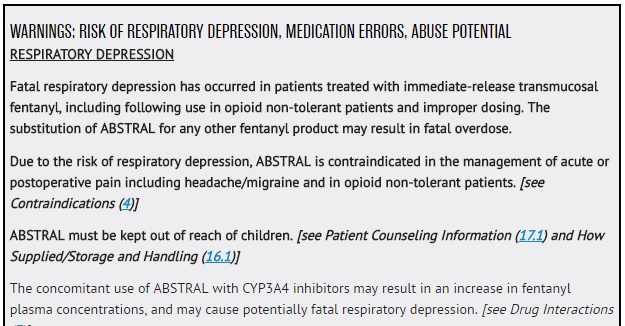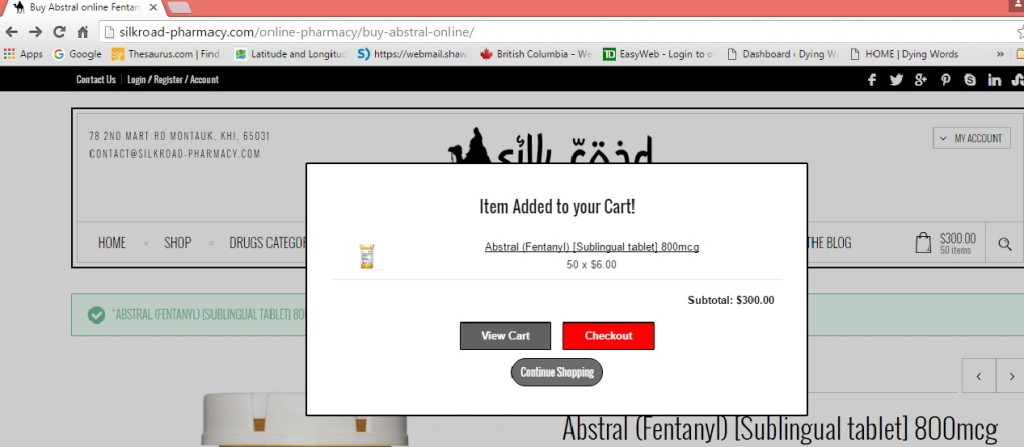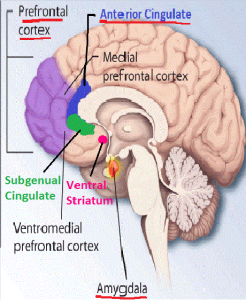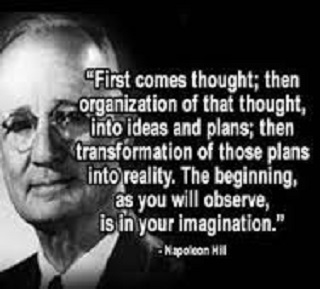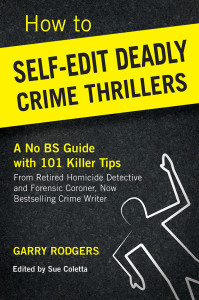 Every serious writer must grasp proper editing principles, regardless of their craft — literary fiction, non-fiction, true-crime, forensic and autopsy reports, short stories, essays, blog posts, legal judgements, copywriting, screenplays, employee assessments, business correspondence, requests for laboratory analysis, letters of reference and resignation, agent queries, and… especially when penning a deadly crime thriller. There’s no escape from effective editing because perfection is the mark of a polished professional.
Every serious writer must grasp proper editing principles, regardless of their craft — literary fiction, non-fiction, true-crime, forensic and autopsy reports, short stories, essays, blog posts, legal judgements, copywriting, screenplays, employee assessments, business correspondence, requests for laboratory analysis, letters of reference and resignation, agent queries, and… especially when penning a deadly crime thriller. There’s no escape from effective editing because perfection is the mark of a polished professional.
But most of us can’t afford a professional copy editor, let alone paying thousands for a full developmental hand-holding. Learning to competently self-edit takes tremendous effort and amounts to taking a personal scalpel to your work, using the eye of a voyeur and the ruthlessness of an ax murderer. It also pays to have the conscience of a psychopath in being objective.
This weekend I’m releasing the detailed guide How To Self-Edit Deadly Crime Thrillers on Amazon—but I sure as hell didn’t do it alone.
Under Sue Coletta‘s eagle-eyed editing—Sue’s my collaborating, bestselling crime writer—and with contributions from twenty other prominent professional writers and editors, this No BS Guide With 101 Killer Tips is designed to help your self-editing process, no matter what your line of work. It’s simply the best collection of self-editing advice we can find.
From the No BS Guide, here are 22 of the top 101 tips for self-editing.
Tip #22 — Understand Conventional Editing Stages
All editing stages overlap and there are different industry terms for the same thing—lines between each type of edit being blurry rather than bold. The clearest explanation I’ve found comes from Marcy Kennedy, a writer and editor who has her own great series of craft guides. (Check her website on my resource web page.) Click Here
Marcy says:
“To me, there are Development edits and Copy edits. That’s it. Developmental edits address the story structure, the telling of the story, the comprehension of the story, the consistency of the story, and every element that makes the story complete, engaging, and tight. Copy edits do not address story issues. They address grammar, punctuation, spelling, typos, formatting, sentence and paragraph structure, word use, etc. But, a good copy editor will alert an author if development issues still exist.”
Let’s look at how the conventional terms fit in.
Developmental or Macro Editing — Deals with the big picture items in layers 1 – 6 on the pyramid. It’s also called outline, comprehensive critique, substantive review, structural assessment, and content edit. This is a look at story issues—characterization, setting, plot, show vs tell, backstory, POV, dialogue, pacing, goals, stakes, and motivation.

Marcy Kennedy – Writer & Contributing Editor
Line or Micro Editing — Covers more easily fixed issues like word choice, paragraph flow, awkward sentences, eliminating redundancy, catching clichés, and style quirks. It’s about identifying weak and murky spots. It hovers between levels 4, 5, & 6.
Copy Editing — Makes the manuscript follow the rules of grammar, punctuation, spelling, and word choice in layer 7, but it’s not beyond recognizing problems still living in the lower layers.
Formatting — Gets the manuscript ready for submission to the next set of eyes, whether it’s to another editor, agent, publisher, or uploading to eBook format. It’s taking a complete, working manuscript and making it an acceptable, professional document.
Proof or Script Reading — Corrects typos and other overlooked errors like punctuation, capitalization, numerals, and spacing. No big changes are made at this stage. It’s your last minute check because none of the previous stages will catch everything.
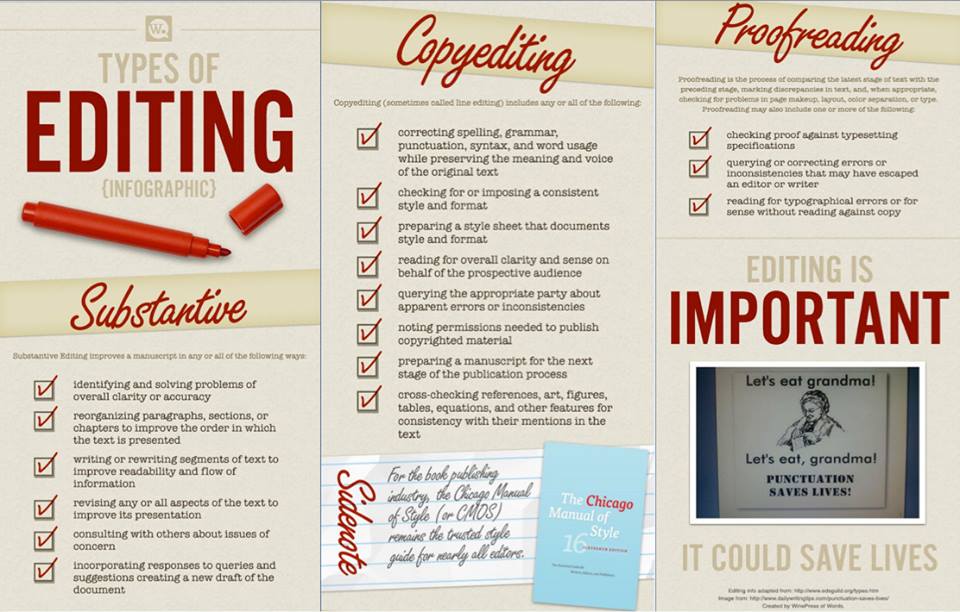
Tip #21 — Revision vs Editing
You could say all revising is editing, but not all editing is revising. Huh? In that play-on-words, editing is not looked at as changing anything big. By the time you get to the “editing” stage, all the heavy work is done. Take this for what it’s worth, but it fits with two self-editing acronyms you should know:
- Revision is ARMS — Add. Remove. Move. Substitute.
- Editing is CUPS — Capitalize. Usage. Punctuation. Spelling.
Tip #20 — Four Pillars of Revision
I like this quote, although for the life of me I can’t remember where I got it. Outstanding writers primarily master a limited number of the most important writing principles. While self-editing, pay attention to the four pillars of writing and revision.
- Structure — Organizing the order.
- Style — Voice. How you write.
- Readability — Your presentation.
- Grammar — The correct and acceptable form.
Tip #19 — Next-Day Revision
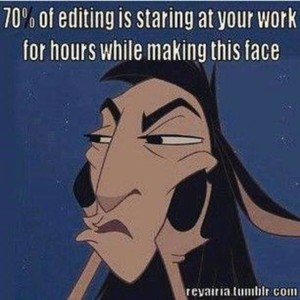 You’ll hear advice from seasoned writers, like Stephen King, that it’s best to just bang away at the first draft until it’s done, then go back and start the revision process—rationale being that it’s more important to keep the words flowing. Fix it later, he says. I’m not so sure about that, but then keep in mind that Stephen King has natural story sensibilities, so it works for him. You and I, on the other hand, should probably use a more pro-active approach.
You’ll hear advice from seasoned writers, like Stephen King, that it’s best to just bang away at the first draft until it’s done, then go back and start the revision process—rationale being that it’s more important to keep the words flowing. Fix it later, he says. I’m not so sure about that, but then keep in mind that Stephen King has natural story sensibilities, so it works for him. You and I, on the other hand, should probably use a more pro-active approach.
I do next-day revision and all I can say is that it works for me. It keeps me grounded in the story and allows to me look at it with fresh eyes in the morning. On a good day—a really good day—I get around 2,500 words done. When I look at the previous day’s work, I invariably find glaring errors, overwriting, and general structure issues.
It really helps keep the story in perspective. The way I look at it—if you were to peck away until 80K words were done, it’d be a long time since you hid that dwarf in the closet. When you go back over that early chapter in a month or two, you’ll have no frickin’ idea why you stuffed him there in the first place.
Tip #18 — Get Into An Editing Mindset
Writing and editing are two separate processes, each stemming from two different parts of the brain. Writing is mostly subconscious, from the creative right-brain. Editing is consciously done, using the analytical left-brain.
 When we read our own writing, we tend to not actively read what’s on the screen or page. We see what we intended to write. Something happens in our brain that changes how we see the words. The more familiar we are with our own words, the more difficult it is to spot errors. Because of this subjective view, it’s exceedingly difficult to self-edit if we stay in a writer’s mindset.
When we read our own writing, we tend to not actively read what’s on the screen or page. We see what we intended to write. Something happens in our brain that changes how we see the words. The more familiar we are with our own words, the more difficult it is to spot errors. Because of this subjective view, it’s exceedingly difficult to self-edit if we stay in a writer’s mindset.
There was a research project in the U.K. that tested readers’ ability to read past errors. Because we’ve been conditioned to read the first and last letters in a word, we’re often unaware that we subconsciously absorb reversals of letters. This is inherently compounded when we re-read our own work, as we’re conditioned by already knowing the material, especially if it’s fresh in our mind. This example is an eye-opener:
Tip #17 — Put the Manuscript in a Drawer
You hear this tip from everyone and it’s the frickin’ gospel. Nothing gives you a more objective view of your work than some time off. Most writers suggest taking at least a month after finishing the first (rough) draft before going to even the macro edit. I think two months is better, if your deadline can afford it.
Tip #16 — Less Is More
This is another top tip that writers hear repeatedly. It’s time to repeat it again. With every part of your work, ask yourself these three questions:
- What do I not need to say?
- What job is this doing?
- If I remove it, will the piece fall apart?
 Effective brevity is the mark of a great writer—simplicity and economy. Knowing what to cut—and what not to cut—is a major skill in self-editing. There’s a balance, though, and common sense dictates that purpose calls the shot if a piece stays or goes.
Effective brevity is the mark of a great writer—simplicity and economy. Knowing what to cut—and what not to cut—is a major skill in self-editing. There’s a balance, though, and common sense dictates that purpose calls the shot if a piece stays or goes.
Consider why you placed it. Does it have meaning? Does it carry sound and rhythm, which is the physicality of language? But be careful with this. If you cut simply because the material doesn’t have immediate meaning, you risk missing out on other aspects of language, which is the vehicle of storytelling.
Here’s a great tip from thriller writer Alexandra Sokoloff:
“The most useful tool for editing is a single word: WHY? Why is my character doing this? Why is my character doing this now? Why is my character doing this here? Why does my character react this way? Why am I writing this scene from this character’s point of view? Why am I choosing these details to describe what my character experiences? Why did I include this? Why? Why? Why?”
Tip #15 — Understand Your Voice
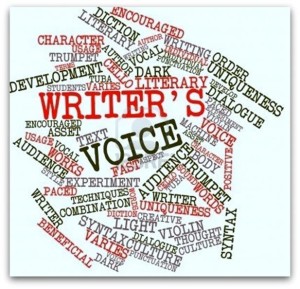 Your writing voice is the one thing that’s unique to you. It’s your most valuable asset—so valuable that you should buy some insurance on it. And it’s the one thing you have to get right. Right from the start. It’d be a bitch to go back and self-edit voice, if it can even be done. But what is “Voice”?
Your writing voice is the one thing that’s unique to you. It’s your most valuable asset—so valuable that you should buy some insurance on it. And it’s the one thing you have to get right. Right from the start. It’d be a bitch to go back and self-edit voice, if it can even be done. But what is “Voice”?
It’s your relationship with language—how you use language. Voice comes from the people you’ve met, the books you’ve read, the education you have, and the worlds you’ve inhabited—not just in your body, but in your mind. It’s your personality. It’s your attitude toward your writing. Your passion shining through your prose.
Voice is your distinctive way of choosing and stringing words together—your writing accent, your views, culture, biases, and formal training. It’s using some goddam profanity every now and then. It’s imagery. Being serious, stuffy, snarky, and sarcastic. Being funny, silly, foolish, and stupid. It’s your level of confidence speaking through. Your rhythm, cadence, tone, and mood. It’s your emotional guts spilling out. It’s relating gut to gut, not brain to brain. No editing in the world can take an intellectual exercise and make it emotional.
Remember, Crime Thrillers aim to evoke emotion in your reader. Get emotional when you write, and then again when you revise. “No tears in the writer. No tears in the reader. No emotion in the reader. No interest in the story.”
I like this definition by Grammar Girl, Mignon Fogarty, who gave me permission to quote her:
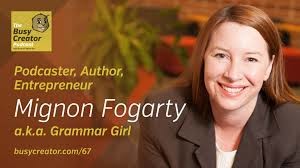 “Voice is the distinct personality, the style, or the point of view in a piece of writing or any other creative work. Voice is what Simon Cowell is talking about when he tells American Idol contestants to make a song their own and not just do a note-for-note karaoke version. Many musicians have played The Star-Spangled Banner, for instance, but there’s a world of difference between the Boston Pops’ performance and Jimi Hendrix’s, even though the basic melody is the same. In writing, the New York Times and the New York Post may cover the same story, but their headlines are likely to be quite different. For example, when Ike Turner died, the New York Times had a straightforward headline: ‘Ike Turner, Musician and Songwriter in Duo With Tina Turner, Dies at 76’; whereas the New York Post went for a bad pun: ‘Ike Beats Tina to Death’.”
“Voice is the distinct personality, the style, or the point of view in a piece of writing or any other creative work. Voice is what Simon Cowell is talking about when he tells American Idol contestants to make a song their own and not just do a note-for-note karaoke version. Many musicians have played The Star-Spangled Banner, for instance, but there’s a world of difference between the Boston Pops’ performance and Jimi Hendrix’s, even though the basic melody is the same. In writing, the New York Times and the New York Post may cover the same story, but their headlines are likely to be quite different. For example, when Ike Turner died, the New York Times had a straightforward headline: ‘Ike Turner, Musician and Songwriter in Duo With Tina Turner, Dies at 76’; whereas the New York Post went for a bad pun: ‘Ike Beats Tina to Death’.”
Is there an ideal voice? Nope. But my advice is to lighten up. Personally, I’m not big on sarcasm or stuffiness. Ever go to a party with lawyers and politicians? I have. They’re boring as shit because they’re bound by the restraints of graduate degrees and academic correctness. Ever hang with cops & corners? I have. They’re a blast. They’re like honey badgers. They don’t give a fuck what they say.
 I like hearing a natural, open, appealing, and charismatic tone and style that draws me in and binds me with storytelling. Ever read foul-mouthed Chuck Wendig? Hilarious crime writer Meg Gardiner? Listen to quadriplegic, blog-king Jon Morrow? Or follow opinionated Johnny B. Truant? Now those folks have a voice. Let’s face it. Some people are just more interesting than others.
I like hearing a natural, open, appealing, and charismatic tone and style that draws me in and binds me with storytelling. Ever read foul-mouthed Chuck Wendig? Hilarious crime writer Meg Gardiner? Listen to quadriplegic, blog-king Jon Morrow? Or follow opinionated Johnny B. Truant? Now those folks have a voice. Let’s face it. Some people are just more interesting than others.
Voice is the way you put words to paper. The way you say it. It’s your personality coming alive on the page. It’s not the paint on the wall. It is the wall. Check out a blog post I wrote called 6 Elements of Your Writing Voice. Click Here.
For your work to be successful, your reader has to hear your voice telling the story. Nothing else matters if she can’t relate to your voice. She wants you to sound confident, intelligent, personal, authentic, trustworthy, and even vulnerable. She wants to be your friend and follow you around.
** Here’s Sue’s editing remark and she’s making a good point — “This statement only holds true if writing in omniscient. If you write in deep POV, the reader must hear “the character’s” voice, not the authors. Not sure how you want to clarify this.” **
I think I’ll just let her remark speak for itself. I have yet to write in Deep POV and she’s mastered the technique.

So, when revising, be natural. Don’t overthink. And be careful not to cut your own voice’s throat.
Tip #14 — Brevity
This piece of revising advice is from Joseph Pulitzer:
“Put it before them briefly so they will read it, clearly so they will appreciate it, picturesquely so they will remember it, and above all, accurately, so they will be guided by its light.”
And then there’s this beauty from William Strunk, Jr. from Elements of Style. No one has ever captured (in 63 words) the essence of brevity in writing:
 “Vigorous writing is concise. A sentence should contain no unnecessary words, a paragraph no unnecessary sentences, for the same reason that a drawing should have no unnecessary lines and a machine have no unnecessary parts. This requires not that the writer makes all his sentences short, or that he avoid all detail and treat his subjects only in outline, but that every word tells.”
“Vigorous writing is concise. A sentence should contain no unnecessary words, a paragraph no unnecessary sentences, for the same reason that a drawing should have no unnecessary lines and a machine have no unnecessary parts. This requires not that the writer makes all his sentences short, or that he avoid all detail and treat his subjects only in outline, but that every word tells.”
This is where the advice, “Resist the urge to explain (RUE)” comes into play. It works with subtext, or what’s best left unsaid, which is a powerful dialogue tool. Say something once and leave it at that. Think superfluous redundancy when editing.
Tip #13 — Look Up Esoteric Words
If you’re going to use hifalutin language, make sure it’s right. Even words you use in everyday, normal speech may be slightly off, but they must be correct in published work. The more audacious you are with language, the more perspicacious you need to be in looking up proper usage. People will only know you should have looked up a word to see what it means if you didn’t.
Do yourself a self-editing favor and keep an online dictionary in your top toolbar. I like Dictionary.com. Click Here
Tip #12 — Little Red Writing Book
One of the best writing, therefore editing, resources I’ve found is The Little Red Writing Book by Brandon Royal. Brandon generously shared this quote:
 “Making changes to your writing is annoying and grueling. But eventually, with changes made, you will likely be satisfied with what you have written and not want to add or delete anything. This is the point at which your writing is finished—your writing is ‘standing still’. Unpolished writing is like shifting sand in a desert storm. Eventually, the storm ceases and the sand sits still. The word ‘finished’, when referring to writing, should really be enclosed in quotation marks because writing is never actually finished. With respect to writing done for everyday purposes, completion is an end in itself. However, for more permanent written works, such as novels, writing can be continued indefinitely because it can always be improved. Even published books can be reworked and re-edited. Weeks, months, and years after a book is published, an author will invariably contemplate changes.”
“Making changes to your writing is annoying and grueling. But eventually, with changes made, you will likely be satisfied with what you have written and not want to add or delete anything. This is the point at which your writing is finished—your writing is ‘standing still’. Unpolished writing is like shifting sand in a desert storm. Eventually, the storm ceases and the sand sits still. The word ‘finished’, when referring to writing, should really be enclosed in quotation marks because writing is never actually finished. With respect to writing done for everyday purposes, completion is an end in itself. However, for more permanent written works, such as novels, writing can be continued indefinitely because it can always be improved. Even published books can be reworked and re-edited. Weeks, months, and years after a book is published, an author will invariably contemplate changes.”
I rate The Little Red Writing Book as a resource right up there with The Elements of Style and On Writing. When I contacted Brandon asking permission to use his quote and comparing it to these timeless books, he replied:
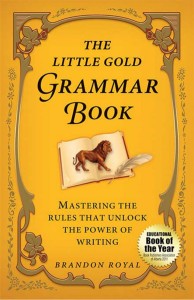 “Here’s how I compare the red book to The Elements of Style, which of course I like and recommend. The Elements of Style is a short grammar book with some style thrown in. The Little Red Writing Book is a style book (Structure, Style, and Readability) with a little grammar thrown in. An indisputable strength of the red book is that it contains short exercises and proposed solutions. After all, how can we learn writing without doing exercises?”
“Here’s how I compare the red book to The Elements of Style, which of course I like and recommend. The Elements of Style is a short grammar book with some style thrown in. The Little Red Writing Book is a style book (Structure, Style, and Readability) with a little grammar thrown in. An indisputable strength of the red book is that it contains short exercises and proposed solutions. After all, how can we learn writing without doing exercises?”
Click Here for Brandon Royal’s website and view all his works, including his updated The Little Gold Grammar Book.
Tip #11 — Common Commas
It’s said that ninety percent of writers use commas correctly seventy-five percent of the time, but only one percent of writers use commas correctly ninety-nine percent of the time. The advice of using the comma whenever you pause is misleading. The best way to understand commas is that they’re divided into four usage types.
- Listing comma — Separates items in a series. “The four main editing processes are rough draft, developmental, copy, and proofread.” The final comma before the word and is optional. It’s called the Oxford or Serial comma. I always use it, because my English teacher drilled it into me, and I’m now too old to change. Besides, you can’t be misunderstood for using it, but leaving it out could get you in trouble. Remember this line — “The highlights of our tour included meeting Nelson Mandela, a ninety-year-old parachutist and a dildo collector.”
- Bracketing comma — Sets off parenthetical expressions. “Sue, also a terrific crime writer, is a deadly editor.”
- Joining comma — Separates independent clauses connected by coordinating conjunctions such as and, but, yet, or, and for. “The entire No BS Guides will be available in one print-on-demand book, yet most readers will download them electronically.”
- Omission comma — Indicates missing words, particularly and. “It was a dark, stormy night.” There’s an interesting way to test this. If you can insert and between dark and stormy, then a comma is required. Also, reverse the words to read, “It was a stormy, dark night.” If the sentence still makes sense, you know a comma is necessary.
Here’s a handy image with twelve comma rules:

Tip #10 — Learn from Other’s Mistakes
I read this in Writers Digest and Chief Editor, Jessica Strawser, allowed me to quote it:
“Wrong-word errors are not only embarrassing but also costly, as publisher Penguin Books Australia can attest. In 2010, they were forced to reprint 7,000 copies of the cookbook Pasta Bible because a recipe called for adding ‘salt and freshly ground black people’ (instead of black pepper). Oops! That slip cost Penguin $20,000 to correct.”
They probably ground up the proofreader.
Tip #9 — Mindset
The right mindset is not just important in self-editing—it’s critical. Writing and editing are solitary disciplines, and it’s human nature to want to socialize. It’s so easy to slip over to Facebook, Tweet something, check email, peek at Pinterest… Here are some bullets of advice that’ll keep your self-editing hat on:
- It’s a chicken and an egg thing. You can’t be a good self-editor without being a good writer, and you can’t be a good writer without being a good self-editor. Practice makes you better (not perfect). Your goal is to maximize professionalism.
 Set specific time aside for editing. I do prefer to write in the morning and edit in the afternoon. I’m always working on multiple projects and this schedule helps efficiency.
Set specific time aside for editing. I do prefer to write in the morning and edit in the afternoon. I’m always working on multiple projects and this schedule helps efficiency.- Deal with distractions. Shut off the TV and radio. I can’t concentrate with blabbing in the background. Set your cell to voice mail. Put out the cat. Feed the dog. Close the door.
- Stay off social media. (Yeah, yeah. Easier said than done.) A prominent writer I know uses a separate computer for her writing and self-editing that doesn’t have an internet connection.
- Some put headphones on and listen to rain sounds and waves, washing on the beach. Try classical, or flute, or harp.
- Go to a different place than where you write. Public libraries work great, and it puts you out with other (quiet) people. That’s until a birthday party arrives with thirty, five-year-olds accompanied by a balloon-animal tying clown that looks like Pennywise from It. That actually happened to me while I was self-editing this guide.
- Now I go to a university library where I can’t get wi-fi without a password. I’m not distracted by the web, and I get energized by all the young people and books around me.
- Get two hats or two vests that say “Writer” and “Editor”. Seriously. I’ve heard of this, and am thinking of trying it myself.
- Get plenty of rest and exercise.
 Take Hemingway’s advice: “Write drunk. Edit sober.”
Take Hemingway’s advice: “Write drunk. Edit sober.”- Focus on what’s best for the book and for the reader, because that will be best for you.
- Develop thick skin. I had a negative comment on my Huffington Post blog the other day and it irked me. I got up, took a break, accepted that the commenter had a point, and learned from it. Get used to it, because you’re going to get some poor reviews. Sometimes mean people are right.
- Track your bad habits. I have a problem with tic-words (just, that, then, turn, actually, and like, are my worst) and with tense switching. I’ve written them in red on my whiteboard and on a little yellow sticky-note beside the screen.
- It’s nearly impossible to “toggle” the creative left brain and instantly make it the analytical right brain. There needs to be a bit of time separation, so take a break between processes. The writer and the editor need to be on vacation from each other.
- Compartmentalize. Focus on one thing at a time. That’s why the pyramid method is so effective. Speaking of effective—whether you like him or not—Bill Clinton was one of the most effective presidents in getting his daily agenda done, and he attributed it to his ability to compartmentalize tasks.
 Know there’s no “magic bullet” to the art and craft of self-editing. It’s a combination of learning and applying the skills and maintaining a passion. The more editing you do, the better writer you’ll become, and the less editing you’ll have to do as your career advances. And that’s one of the best tips I’ve found.
Know there’s no “magic bullet” to the art and craft of self-editing. It’s a combination of learning and applying the skills and maintaining a passion. The more editing you do, the better writer you’ll become, and the less editing you’ll have to do as your career advances. And that’s one of the best tips I’ve found.- In the Crime Thriller genre, it’s okay to occasionally break the rules. Just know what the rules are and why you’re breaking them when you do.
- Reading other Crime Thrillers is probably the best way to tune your subconscious to absorb the techniques and structure needed to write and edit in the genre. Go to a used bookstore and buy cheap paperbacks. Red ink the snot out of them. Deconstruct their plots. Listen to their dialogue. Analyze their characters. Their scenes. Their pace.
- Read widely. Go outside the genre and read classics, sci-fi, or erotica, if it works for you. If you just read what everyone else in the genre is reading, you’re just going to write what everyone else is writing.
- You’re going to experience self-doubt. We all do. Just keep at it—one word at a time.
- Be active on social media. Find people like you on the internet. Don’t be afraid to reach out and connect. That’s how Sue and I met. Make Facebook friends. Say Hi on Twitter. Share things. Comment on blogs and encourage others. You’ll find the writing community is exceptionally generous, as long as you’re genuine and also help others.
- Believe in yourself. If I can write a bestseller, you sure as hell can, too.
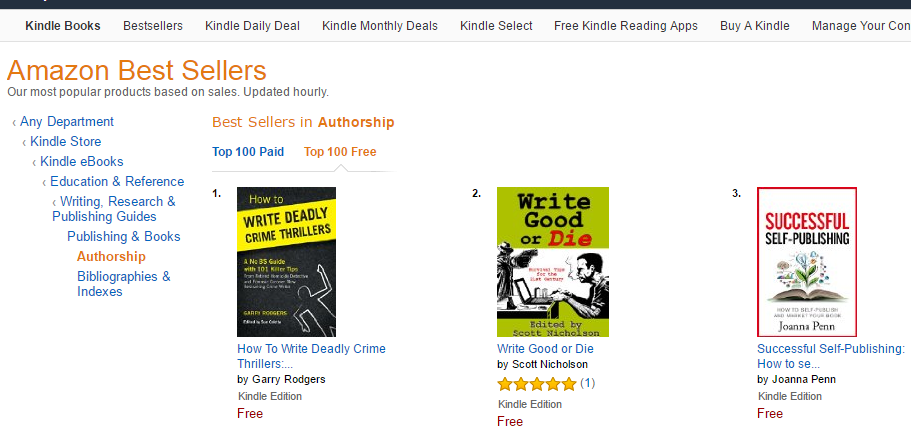
Tip #8 — Other Practical Stuff
The last tip was mostly theoretical. These next bullets mean to be practical. In no particular order:
- Put time between stages. I’ve said this before, but it bears repeating. I think it’s the most important tip. How much? As much as you can.
- Run electronic spelling and grammar checks first. This quickly finds multiple errors and gets them out of the way, saving time and energy, which you can spend on improving structure, characters, and dialogue—or better yet, working on your next Crime Thriller.
- Edit in a different medium than you write. Print off your manuscript and red ink it. Go to a different computer screen size. Change the font type or size. Change the spacing. Change the color. Download it as a pdf.
- Read out loud. Great tip! Works like a hot damn (excuse cliché), especially for dialogue. If you have to breathe more than three times in one paragraph, it’s too long for a Crime Thriller.
- Ask, “Would anyone really do, think, or say this?”
 Read backward. Weird, but it works. This is because when you write, your brain knows where it wants the next sentence to go. In reverse, the familiar pieces become foreign and your focus improves.
Read backward. Weird, but it works. This is because when you write, your brain knows where it wants the next sentence to go. In reverse, the familiar pieces become foreign and your focus improves.- Proofread chapters out of order. This takes you out of the story to view it from a different perspective.
- Proofread line-by-line with a ruler.
- Proofread one word at a time.
- Attack show vs. tell with two different colored hi-liters. Use yellow for show and green for tell. Watch the color patterns.
- Print your margin notes neatly. Nothing’s worse than going back and saying WTF was that about?
- Double space your working manuscript.
- Edit while writing. If something is obviously wrong, fix it right then.
- If something is troubling, but you can’t quite figure out why BOLD IT and move on. Don’t break the flow. It’ll be easy to spot later on.
Tip #7 — Saving Your Work
Okay, this sounds like a no-brainer, but if you’ve ever lost thousands of words because you were too busy/careless/forgetful/stupid to back-up (like I’ve done) you’ll never let that happen to you again. Here are some saving suggestions:
- Save to the cloud. Simple and foolproof. (Until the cloud crashes)
- Use an online saver.
 Data sticks. USB sticks. Thumb drives. Flash drives. Whatever you want to call ‘em. Small-bite ones are cheap—actually free as promotions from some vendors. I picked up a box full of 2-Gigs at a trade show.
Data sticks. USB sticks. Thumb drives. Flash drives. Whatever you want to call ‘em. Small-bite ones are cheap—actually free as promotions from some vendors. I picked up a box full of 2-Gigs at a trade show.- External hard-drives with auto-timed backup. Could be a cheap investment.
- Hit save often. Every five hundred words or five minutes, whichever comes first.
- Make each revision a Save-As file with a revision number and date in the title.
- Make a separate folder for each manuscript rather than storing in general documents.
- Save in several document formats. I recommend Word, Word.doc, and Rich Text as they format best with outside parties.
Tip #6 — Tap Into Technology
Think about how far we’ve come in writing technology that makes self-editing so, so much simpler—the chisel and tablet, quill pen & ink, ballpoint and legal pad, ribbon typewriter, carbon paper, whiteout, word processor, MS Word, Scrivener, Google Docs, SIGIL, JUTOH, Calibre, WPS Writer, Adobe in Design, Page Plus… what’s coming next?
Here’s a look at tech-stuff I’ve found:
MS Word
 Spend time getting to know the editing features in Word. I’ve tried other software like Scrivener, but it has a steep learning curve. When I found out that your manuscript still has to be reformatted from Scrivener to Word for submissions to an agent or publisher, as well as for HTML formatting as an eBook, I didn’t see much advantage to it. It does have some cool features for organizing your projects, though.
Spend time getting to know the editing features in Word. I’ve tried other software like Scrivener, but it has a steep learning curve. When I found out that your manuscript still has to be reformatted from Scrivener to Word for submissions to an agent or publisher, as well as for HTML formatting as an eBook, I didn’t see much advantage to it. It does have some cool features for organizing your projects, though.- The entire publishing industry uses Word. Want to know why? Click Here Eventually your manuscript is going to be put into Word to become a book, so you might as well get used to it.
- Get familiar with Track Changes — Accept/Reject, Balloons, Bubbles, Insertions, Deletions, Strike-throughs, Underlines, Show Markup, as well as Final and Original Views.
- Know the Keyboard Shortcuts for MS Word. This is an immense time saver. Click Here
- Use WordTips. This website is an excellent resource for using MS Word. Click Here
- Learn to make self-editing macros — Great stuff at TechTools For Writers. Click Here
- Use the biggest ass-saver in the system—CTRL+Z—which is Word’s undo feature.
Editing Software
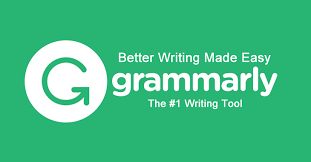 There is a lot of software available for both PC and Mac—some free, some expensive—but remember you usually get what you pay for. Here’s a list of the most popular that I’ve found, not in any particular order.
There is a lot of software available for both PC and Mac—some free, some expensive—but remember you usually get what you pay for. Here’s a list of the most popular that I’ve found, not in any particular order.
I can only vouch for Grammarly because I downloaded the free version to try out on this manuscript. So far, I love it, but then Sue loves her Word editing feature. Don’t you, Sue? I can’t vouch for any of the others because I haven’t used anything except their demos:
- Grammarly — Love it. Wouldn’t live without it.
- StyleWriter4 — Oldest in the business and seems to be the most popular. It’s an add-on for MS Word. Free on 14-day trial.
- GrammarCheck — Appears excellent. The basic model is free.
- Ginger — New kid on the block and is stealing the show.
- StackEdit — Very sophisticated.
- Hemingway App — Very popular, especially for blog posts. Works great for brevity.
- Markable — Sophisticated but user-friendly.
- Write URL — Simple & free.
- Quabel — Claims to be distraction-free and lives in your browser, whatever that means.
- editMinion — Great for first passes and picking up grammar, adverbs, and passive voice. Basic is free.
- ProWritingAid — Free to 3K words and works with Word & Scrivener. Great for checking blog posts.
- AutoCrit — Free under 500 words.
- SmartEdit — Fully free for 10 days.
- WordRake — Free for 7 days.
- Wizards For Authors — Templates for novel writing and editing.
- Cliché Cleaner — Kinda interesting.
- WriteWords — Word and phrase frequency finder.
Links to these editing software sites are on my website’s resource page. Click Here
Text-To-Speech (TTS) Generators
 These things are cool on one hand and annoying on the other. You cut & paste your text into them and they audibly read it back to you. Some are great, with different accents and languages. Some are terribly robotic. It’s another “you get what you pay for” thing. In no particular order, here’s some of what’s out there:
These things are cool on one hand and annoying on the other. You cut & paste your text into them and they audibly read it back to you. Some are great, with different accents and languages. Some are terribly robotic. It’s another “you get what you pay for” thing. In no particular order, here’s some of what’s out there:
- Adobe Read-Out-Loud — Converts pdf to voice.
- NaturalReader — Seems high quality.
- NeoSpeech — Also seems high quality.
- OddCast — Free demo and multi voices.
- FromTextToSpeech — Fairly basic.
- Text2Speech — Free and versatile.
- YAKiToMe! — Free and easy to use.
- ReadSpeaker — Sophisticated.
- Ivona — Amazon’s TTS app.
- iSpeech — Very high quality.
- SpokenText — Minimal but free.
- ImTranslator — Great for English second language writers.
Links to these Text-to-Speech software sites are on my website’s resource page. Click Here
Tip #5 — Editor-Ready Checklist
This tip is shared by freelance editor and author Tanya Egan Gibson who published this Are You Ready for a Freelance Editor eight-point checklist in Writers Digest:
-

Tanya Egan Gibson – Contributing Editor
This is not my first draft of my manuscript. I have written several drafts.
- I have waited at least three weeks since writing my last draft and have then reread it.
- I honestly feel that my manuscript is as strong as I can make it.
- I am ready to hear honest feedback that might require me to do a significant amount of additional work.
- I understand that an outside reader’s reaction to what I’ve written may be different from what I intended that piece to convey.
- I really want to learn how to make this piece the best it can be—and am willing to do what it takes to accomplish that.
- Which of these problems offer the most potential for conflict and drama?
- How does this problem affect other characters?
When you can answer “yes” to each point, then you’re ready for other eyes.
Tip #4 — Proofreading
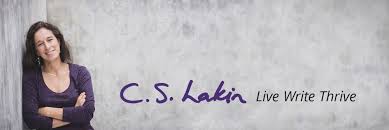
Susanne Lakin – Writer and Contributing Editor
Final proofreading is done after all the other editing steps are complete. Although proofreading is an ongoing process—if you see an obvious error anywhere along the way, it makes sense to correct it then—the real proofread comes after formatting is finished. Keep in mind that copy editing is making sure the content is absolutely right before formatting. Proofreading is about catching small errors after your formatting is done, like these:
- Spelling, punctuation, and typos.
- Small grammatical errors.
- Small stylistic problems.
- Misused words.
- Layout errors.
- Inconsistent spacing in sentences and paragraphs.
Tip #3 — Legal Stuff
Copyright infringements are serious matters and they apply to written content, song lyrics, poetry, verbal quotes, online images, and many other expressions.
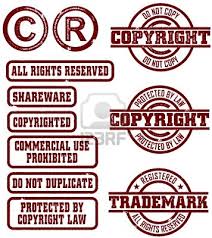 Copyright protection is a gray area, and the best advice for using someone else’s original material is to simply ask permission. It’s so easy to do in the electronic age. Just send a polite email explaining what you’d like and make sure you offer full attribution for the material.
Copyright protection is a gray area, and the best advice for using someone else’s original material is to simply ask permission. It’s so easy to do in the electronic age. Just send a polite email explaining what you’d like and make sure you offer full attribution for the material.
I’ve done that with every contributor to this guide with the exception where I’ve only referenced and linked their Open Source—Public Domain content. That’s different from directly cutting and pasting into your work. Here’s an example of permission not being necessary, where I simply link to Jane Friedman’s website and her valuable article on the Fair-Use Doctrine. Click Here
You’ll eventually have a copyright page in your published book, regardless if indie or traditional, and it should conform to the standard of the country you’re publishing in. Each country has a slightly different twist on copyright protection, but there is one universal principle that applies. Here’s a Fair-Use quote from the U.S. Patent Office website:
“Copyright does not protect ideas, concepts, systems, or methods of doing something. You may express your ideas in writing or drawings and claim copyright in your description, but be aware that copyright will not protect the idea itself as revealed in your written or artistic work.”
Translation: The words may be yours, but the idea belongs to everyone. There’s a big difference between the general concept of an idea and your unique, written expression.
 What’s this got to do with tips on self-editing Crime Thrillers? Lots. When using material that came from somewhere else, always ask permission and get it in writing. It’s ass-covering at its worst and tremendous insurance against a lawsuit at its best. After all, you’d expect the same protection for your own unique, written expression.
What’s this got to do with tips on self-editing Crime Thrillers? Lots. When using material that came from somewhere else, always ask permission and get it in writing. It’s ass-covering at its worst and tremendous insurance against a lawsuit at its best. After all, you’d expect the same protection for your own unique, written expression.
Tip #2 — Editing Quotes
These are some enlightening quotes from writers that I thought needed sharing. Yes, they all fall under the open source, public domain, and fair-use doctrine.
- Katerina Klemer — “Manuscript. Meanuscript. Moanuscript. Manurescript. And so on.”
- Stephen King — “Only God gets it right the first time and only a slob says, ‘Oh well, let it go. That’s what copy editors are for’.”
- Russel Lynes — “No writer dislikes self-editing as much as they dislike not being published.”
- Unknown — “A professional writer is an amateur who didn’t quit editing.”
- C J Cherryh — “It’s perfectly okay to write garbage—as long as you edit brilliantly.”
- Steve Martin — “The conscious mind is the editor and the subconscious is the writer. The joy of writing from the subconscious is beautiful. It’s thrilling. When you’re editing, which is your conscious mind, it’s like torture.”
- Anonymous — “The editor’s job is simple. Sort the wheat from the chaff. Point out chaff. Encourage more wheat.”
- Jaclyn Moriarty — “She promised 3K words to her editor by tomorrow and she’d only written eleven, specifically ‘His rhinoceros smelled like a poppadum: Sweaty, salty, strange, and strong.’ She made it on time, but her editor cut that line.”
- Eric Benoit — “Not self-editing is the path to the dark side. Not self-editing leads to self-delusion. Self-delusion leads to missed mistakes. Missed mistakes lead to bad reviews. Bad reviews are the tools of the dark side.”
- Richard Kinlogh — “When I’m writing, I make the words my bitch, but when I’m editing, the words make me their bitch. It all equals out in the end.”
- Don Rolf — “I’ve found the best way to revise your own work is to pretend that someone else wrote it, then rip the living shit out of it.”
- Sue Coletta — “An unedited manuscript is a crime scene.”
- Jarod Kintz — “There are two typos of writers in this world, those who can edit and those who don’t bother.”
- Dr. Suess — “So the writer who breeds more words than he needs is making a chore for the reader who reads.”
Tip #1 — Trust Your Gut
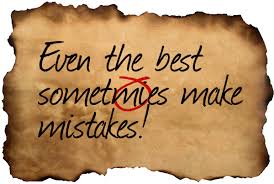 The more you write and the more you self-edit, the more instinctive you’ll become. You’ll inherently know when something’s not working. It doesn’t sound right. It doesn’t look right. It just doesn’t feel right. Trust your gut feeling. Ninety-nine times out of a hundred it’ll be right.
The more you write and the more you self-edit, the more instinctive you’ll become. You’ll inherently know when something’s not working. It doesn’t sound right. It doesn’t look right. It just doesn’t feel right. Trust your gut feeling. Ninety-nine times out of a hundred it’ll be right.
Self-editing is a continuation of your journey, not your end. One book after another, you’ll find it easier to think through editing and developmental issues and work them out for yourself. You’ll grow as an author and as a critical thinker. Your skills will grow stronger and your editing effort will expand beyond merely making your book “work”, but to transcend your genre and influence how people see the world.
And there’s only one editor alive with that type of commitment.
You.
* * *
 How To Self-Edit Deadly Crime Thrillers – A No BS Guide With 101 Killer Tips is now available in Amazon Kindle eBook format. Click Here to download a copy. Don’t let the title fool you, though. It’s primarily aimed at crime-fiction writers but the principles can be applied across the board to all forms of writing.
How To Self-Edit Deadly Crime Thrillers – A No BS Guide With 101 Killer Tips is now available in Amazon Kindle eBook format. Click Here to download a copy. Don’t let the title fool you, though. It’s primarily aimed at crime-fiction writers but the principles can be applied across the board to all forms of writing.
And I’d like to give a word of thanks to all the contributors: Larry Brooks, Will Buckingham, Renni Browne, Shawn Coyne, Shannon Donnelly, Mignon Fogarty, Dr. Kim Foster, Tanya Egan Gibson, Michael Heibert, Beth Hill, Marcy Kennedy, Susanne Lakin, Jessica Page Morrell, Gabriela Pereira, Brandon Royal, Scarlett Rugers, Alexandra Sokoloff, Jessica Strawser, Sarah Kolb-Williams, and Cathy Yardley. And, of course, the biggest thank-you goes to Sue Coletta for her commitment, hard work, and attention to detail.
 Also, the first book in the How To Write Deadly Crime Fiction Series — How To Write Deadly Crime Thrillers – A No BS Guide With 101 Killer Tips is available FREE on Amazon for a five-day KDPS promotion and, as of this morning, it’s sitting in Amazon’s #1 spot in Writing, Researching & Publishing Guides > Writing > Writing Skills. Click Here to download your FREE copy.
Also, the first book in the How To Write Deadly Crime Fiction Series — How To Write Deadly Crime Thrillers – A No BS Guide With 101 Killer Tips is available FREE on Amazon for a five-day KDPS promotion and, as of this morning, it’s sitting in Amazon’s #1 spot in Writing, Researching & Publishing Guides > Writing > Writing Skills. Click Here to download your FREE copy.
The next guide in the series How To Write Deadly Crime Scenes is in the draft stage and I hope to have it published in the next few weeks. The remainder of the eight guides in the series will be released over the summer of 2016.
 Imagine a serial killer causing 256 deaths in your town—within the first four months of this year. Your place would panic. Your doors would be locked. Windows barred. Your streets would be bare with the cops falling flat-out to find the fiend. Does this sound like a far-fetched plot for the next best-seller? Nope. It’s real. It’s happening right here at home and the killer is known. Her name is Fentanyl. She’s heroin’s deadly little sister.
Imagine a serial killer causing 256 deaths in your town—within the first four months of this year. Your place would panic. Your doors would be locked. Windows barred. Your streets would be bare with the cops falling flat-out to find the fiend. Does this sound like a far-fetched plot for the next best-seller? Nope. It’s real. It’s happening right here at home and the killer is known. Her name is Fentanyl. She’s heroin’s deadly little sister. Fentanyl is a high-potency, rapid-onset synthetic opioid drug prescribed for the treatment of chronic pain. It was developed in the 1950’s as an intravenous anesthetic for surgery and evolved into a breakthrough cancer pain treatment in the form of tablets, lozenges, lollipops, and patches. It’s legal and readily available with a prescription and is listed on the U.S., Canadian, and U.K. Schedules as a controlled drug.
Fentanyl is a high-potency, rapid-onset synthetic opioid drug prescribed for the treatment of chronic pain. It was developed in the 1950’s as an intravenous anesthetic for surgery and evolved into a breakthrough cancer pain treatment in the form of tablets, lozenges, lollipops, and patches. It’s legal and readily available with a prescription and is listed on the U.S., Canadian, and U.K. Schedules as a controlled drug.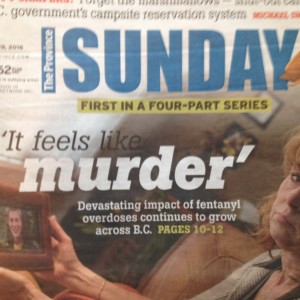 But fentanyl is 100 times more potent than morphine and 50 times stronger than pharmaceutical grade, 100% pure heroin. It’s also far more available on the street than heroin and the reason is profit. One kilogram of heroin sells in Vancouver for $60,000—if you could find one. One kilo of fentanyl powder goes for $125,000 and is readily available. Not hard to figure out what’s going on.
But fentanyl is 100 times more potent than morphine and 50 times stronger than pharmaceutical grade, 100% pure heroin. It’s also far more available on the street than heroin and the reason is profit. One kilogram of heroin sells in Vancouver for $60,000—if you could find one. One kilo of fentanyl powder goes for $125,000 and is readily available. Not hard to figure out what’s going on. The toxicity of all drugs is rated on an LD50 scale, whereas the Lethal Dose of 50 percent of humans occurs at a certain scale which is proportionate to body mass. Fentanyl’s LD50 rating is .03 mcg/kg (micrograms per kilogram). Given that a microgram is .001 of a milligram, this equals an average 70 kilogram (155 pound) person requiring 2.1 mgs of fentanyl to kill them. Some, already tolerant to opioids, require more. Some, with no tolerance, require less. Especially if mixed with other drugs or alcohol.
The toxicity of all drugs is rated on an LD50 scale, whereas the Lethal Dose of 50 percent of humans occurs at a certain scale which is proportionate to body mass. Fentanyl’s LD50 rating is .03 mcg/kg (micrograms per kilogram). Given that a microgram is .001 of a milligram, this equals an average 70 kilogram (155 pound) person requiring 2.1 mgs of fentanyl to kill them. Some, already tolerant to opioids, require more. Some, with no tolerance, require less. Especially if mixed with other drugs or alcohol. Ten years ago, when heroin was so popular, it was available from a natural product through a complex delivery system which requires a chain from the country of source—China, Afghanistan, and Vietnam to name a few—through international couriers, middle-men, and street dealers before it ever reached the end-user. The junkie in the alley.
Ten years ago, when heroin was so popular, it was available from a natural product through a complex delivery system which requires a chain from the country of source—China, Afghanistan, and Vietnam to name a few—through international couriers, middle-men, and street dealers before it ever reached the end-user. The junkie in the alley. Now you can go online and order any amount of fentanyl—a synthetic and easily mass-produced opioid—you want, as long as your money goes through. Visa, Mastercard, Paypal, and Bitcoin are fine and UPS will deliver it right to your door. Presto, you’re in the illicit drug business.
Now you can go online and order any amount of fentanyl—a synthetic and easily mass-produced opioid—you want, as long as your money goes through. Visa, Mastercard, Paypal, and Bitcoin are fine and UPS will deliver it right to your door. Presto, you’re in the illicit drug business.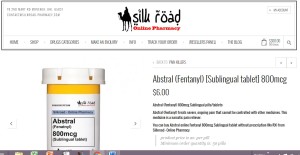 Abstral is a brand name for a formulation of fentanyl citrate (the salt produced by combining the chemical base for fentanyl with citric acid) and is available as a sublingual tablet—one you dissolve under your tongue and is absorbed in your buccal mucosa to provide rapid analgesia. And it comes with this warning:
Abstral is a brand name for a formulation of fentanyl citrate (the salt produced by combining the chemical base for fentanyl with citric acid) and is available as a sublingual tablet—one you dissolve under your tongue and is absorbed in your buccal mucosa to provide rapid analgesia. And it comes with this warning: Now, I don’t have anything against anyone in particular so I propose to do this randomly.
Now, I don’t have anything against anyone in particular so I propose to do this randomly. Talk about a return on the dollar. That’s under twenty-five bucks a death—the price of five coffees at Starbucks—three beers and a burger at The Palace. The chances of getting caught are practically nil. Random stranger-to-stranger killings are the hardest to solve and the easiest to get away with. Just ask the Chicago Tylenol Poisoner.
Talk about a return on the dollar. That’s under twenty-five bucks a death—the price of five coffees at Starbucks—three beers and a burger at The Palace. The chances of getting caught are practically nil. Random stranger-to-stranger killings are the hardest to solve and the easiest to get away with. Just ask the Chicago Tylenol Poisoner.

